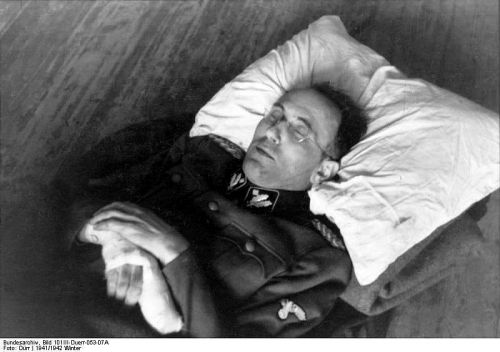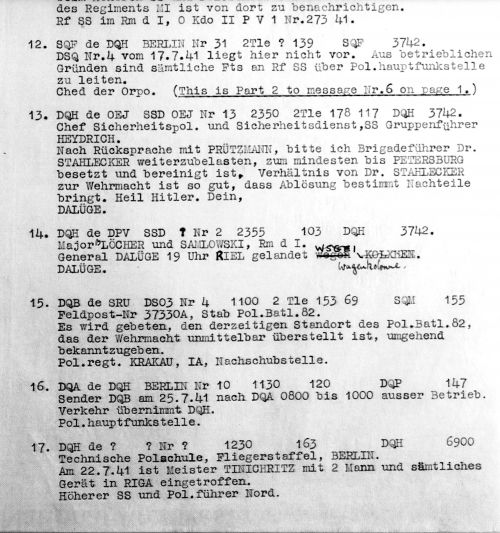Franz Walter Stahlecker

Franz Stahlecker on his deathbed (Bundesarchiv)
Franz Walther Stahlecker was born on October 10, 1900, in Sternenfels, Baden Wurttemburg. He was the second of three sons of the pastor and director of studies Eugen Stahlecker and his wife Anna.
He served in the military from September 21, 1918, to December 7, 1918. From 1919, to 1920, Stahlecker was a member of the Deutschvolkischer Schutz und Trutzbund and the Organisation Consul. He studied at the University of Tubingen, where he achieved a doctorate of law in 1927. On October 14, 1932, he married Luise-Gabriele Frelin von Guttlingen, and they bore four children.
On May 1, 1932, Stahlecker joined the Nazi Party as well as the SS, his SS Number was 73041. On May 29, 1933, he was appointed deputy director of the Political Office of the Wurttenburg State Police. In 1934, he was appointed head of the Gestapo in Wurttenburg and was soon assigned to the main office of the Sicherheitsdienst (SD).
On May 11, 1937, he became head of the Gestapo in Breslau. After the Anschluss of Austria in March 1938, Stahlecker became the SD chief of the Danube District, a post he retained after being promoted to the rank of Standartenfuhrer. In the summer of 1938, Stahlecker became Inspector of the Security Police in Austria, succeeding Gestapo chief Heinrich Mulller in that role. As of August 20, 1938, Stahlecker was the formal head of the Central Agency for Jewish Emigration in Vienna, though its de facto leader was Adolf Eichmann.
Differences of opinion with Reinhard Heydrich, head of the SD, motivated Stahlecker to move to the Foreign Office, after which he held posts as the commander of the Security Police (SIPO) in the Protectorate of Bohemia and Moravia under the control of SS-Brigadefuhrer Karl Hermann Frank. In mid-October 1939, Adolf Eichmann and Franz Stahlecker decided to begin the implementation of the ill-fated Nisko plan in Poland.
On April 29, 1940, Franz Stahlecker arrived in Oslo, Norway to serve as the Higher SS and Police Leader and he was promoted to the rank of SS-Oberfuhrer. On February 6, 1941, Stahlecker was promoted to the rank of SS-Brigadefuhrer and Generalmajor der Polizei. He assumed command of Einsatzgruppe A, with the aim of furthering his career within the RSHA.
In June 1941, with the invasion of the Soviet Union, Einsatzgruppe A followed Army Group North, and operated in the Baltic States, and areas up to Lenningrad. It had the mission of hunting down and murdering Jews, Gypsies, Communists and other groups that the Nazis claimed were 'undesirable.'
By the winter of 1941, Stahlecker reported to Berlin that Einsatzgruppe A had murdered 249,420 Jews. He was appointed as commander of the Security Police and the SD of the Reichskommissariat Ostland, which included the occupied territory of Estonia, Latvia, Lithuania, and Bielorussia, at the end of 1941.

Police Decoded Message Mentioning Stahlecker, Heydrich, Prutzmann and Daleuge (National Archives Kew)
Franz Stahlecker was fatally wounded in action against the partisans on March 22, 1942, in Gatchina, when he was shot in the leg. The bullet had severed a main artery and he bled to death on March 23,1942, on a JU52 Airplane hospital transport. His funeral was held at the Hradcany Castle in Prague. Reinhard Heydrich attended the funeral, along with his wife, and two of his children.
Sources
Wikipedia
French L. Maclean, The Field Men, Schiffer Military History, Atglen PA, 1999
Photograph: Bundesarchiv
National Archives Kew
© Holocaust Historical Society September 27, 2021

